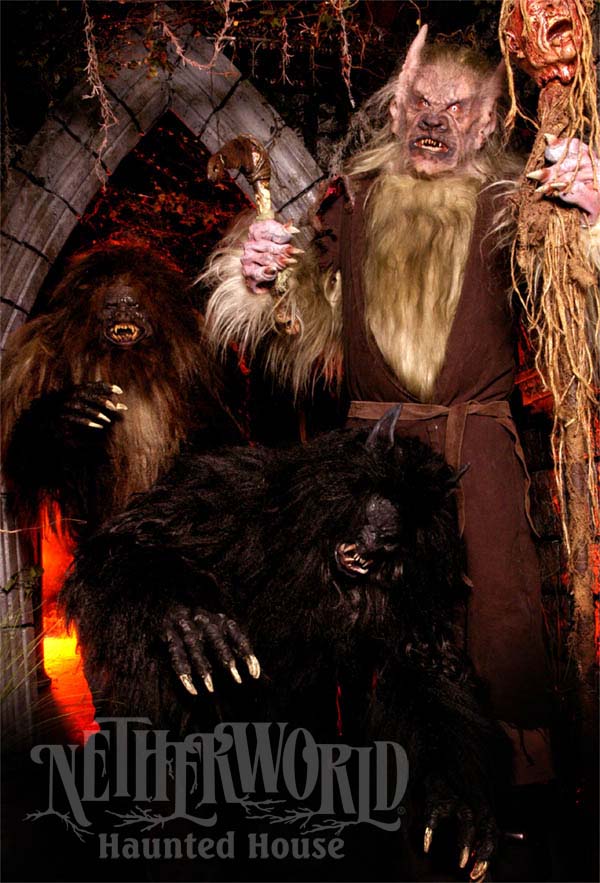NETHERWORLD Monster of the Month: February 2012 Werewolves!
February 7, 2012 marks this month’s full moon. Looming brightly overhead, it will illuminate the evening sky like no other night. Romantic, exciting and mysterious, it will bring about the promise of heightened magical phenomena. And with it comes the rabid threat of lycanthropes. Otherwise known as werewolves.
Werewolves. Hungry, ravenous, and brutal. Stalking their prey, their fevered minds consumed with bloodlust, they hide among us by day in human form as they await the burning glow of the full moon. Pity the unfortunate soul who feels the hot, foul breath of one of these canine killers on his or her neck some enchanted evening.
The legend of the werewolf can be traced as far back as Ancient Greece. The lycanthrope is able to shapeshift into a wolf, or wolf-like creature, typically with the rise of a full moon as the result of a curse. Endowed with superhuman strength and senses, the werewolf has become a fixture of horror iconography over the years.
In the second century, the Greek Pausanius told of Lycaon, who was transformed into a wolf after the ritual murder of a child. It was said that he served human flesh to Zeus in order to discover if he was really a god. Lycaon’s transformation to a wolf was punishment for his crimes, and paved the way for similar tales of humans paying a penance for transgressions against others. Although certain legends detail the change from human to lycanthrope as magical, through various rites, the most common explanation seemed to revolve around curses, vengeance and punishment.
However, in some cultures it was believed that those suffering from epilepsy were actually werewolves, and that children born under a new moon were destined to transform. As many believed that insanity and lunacy were influenced by the phases of the moon, it makes sense that this particular myth would be connected so closely to the moon at its most powerful (it is theorized by some authors that the legend of the werewolf originated as a means to explain serial killings, as modern patterns of such killings reflect those attributed to alleged werewolf attacks of the past). The idea of one becoming a werewolf due to an infected bite from another actually has no roots in myth or legend, but rather is a product of horror fiction.
The same can be said for the legend regarding a werewolf’s vulnerability to silver bullets. European legend would indicate that the only traditional methods of curing lycanthropy stem from treatment with medicines, such as wolfsbane, through surgical means, or by practice of exorcism (admittedly these methods often led to the death of the patient). Other cures involved stabbing the creature in the head, piercing its hands with nails, or simply stating its Christian name three times.
Beetlejuice. Beetlejuice. Beetlejuice. No more werewolf…?
Unlike the myths surrounding vampires, there was not much in the way of classic werewolf literature to outline contemporary understanding of the legend. Other than an occasional mention in various fictions, the werewolf was relatively absent from entertainment until the onset of films and the popularity of the growing horror genre and the wonder of the monster movies of Universal Studios.
In 1935,the werewolf became a star of the silver screen. “Werewolf of London” featured actor Henry Hull as a British scientist afflicted with lycanthropy. Several years later, 1941’s “The Wolf Man” starred Lon Chaney, Jr. as the tortured Larry Talbot, and soon the werewolf was a staple of cinema. “An American Werewolf in London”, “The Howling”, “Wolf”, and the “Underworld” series have kept the loping man-wolf alive and as popular as ever. Television’s “True Blood” and “The Vampire Diaries” have both given us their own spin on the shaggy monsters, as well.
The werewolves of Netherworld Haunted House need no full moon to unleash their unique breed of terror on the forces of the Netherworld invasion of Earth. As each day’s sun descends into darkness, they fight alongside the Illuminati and launch an all-out animalistic assault on the many gargoyles, goblins, ogres and Nightmare Kings that seek to bring about the destruction of the mortal realm. The bloodcurdling growls and howling of these monstrous warriors can be heard echoing throughout the winding chambers of Atlanta’s premier haunted attraction, a horrifying reminder that they walk among us.
Wolfsbane, silver bullets, and exorcisms may take a toll on the cursed werewolf, but one thing that will not die is the popularity of man’s best friend’s deadly brethren.


